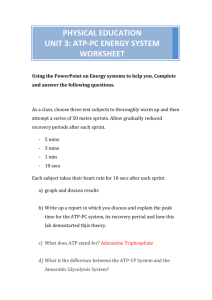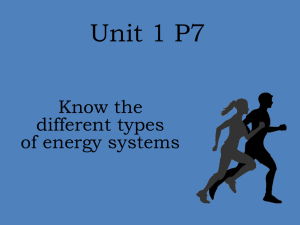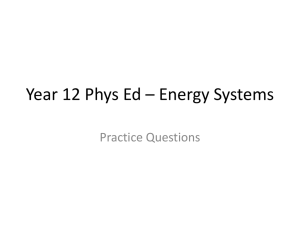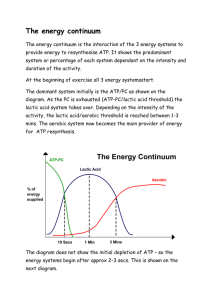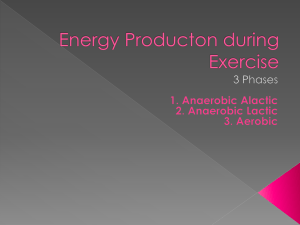ENERGY SYSTEMS
advertisement
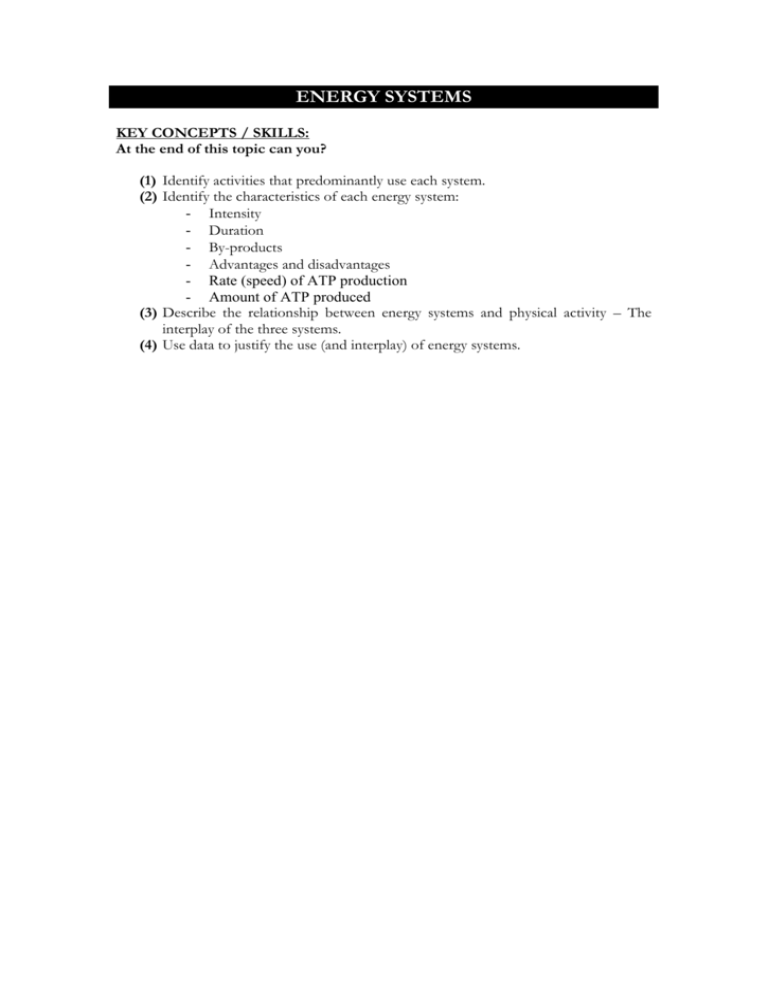
ENERGY SYSTEMS KEY CONCEPTS / SKILLS: At the end of this topic can you? (1) Identify activities that predominantly use each system. (2) Identify the characteristics of each energy system: - Intensity - Duration - By-products - Advantages and disadvantages - Rate (speed) of ATP production - Amount of ATP produced (3) Describe the relationship between energy systems and physical activity – The interplay of the three systems. (4) Use data to justify the use (and interplay) of energy systems. The ATP-PC System The ATP-PC System is the least complicated of the three energy systems and creates energy the quickest (anaerobically). It uses a fuel (PC) found within the muscle. PC is depleted after 10-15 secs. THE ATP-PC SYSTEM – The energy created by the breakdown of PC enables the replenishment of ______________________. ATP then splits again to create ADP and energy is released. This cycle continues until the PC is depleted. After this the lactic acid and aerobic systems will provide more of the ATP required to fuel muscular contractions. There is approx. three to four times as much PC in the muscle as ATP. Given this, explain why, after 5 seconds of exercise there would be more ATP present in the muscle than PC? _____________________________________________________________________ _______ _____________________________________________________________________ _______ _____________________________________________________________________ _______ _____________________________________________________________________ _______ What is Creatine Monohydrate (p.349)? ____________________________________________ What is the major benefit of creatine supplementation (p.351)? _____________________________________________________________________ _______ _____________________________________________________________________ _______ _____________________________________________________________________ _______ How does creatine supplementation enhance performance in intermittent sports (p351)? _____________________________________________________________________ _______ _____________________________________________________________________ _______ _____________________________________________________________________ _______ As a result of anaerobic training, skeletal muscles hypertrophy. As a result the muscle stores more PC. How does this assist in greater performance in anaerobic events? _____________________________________________________________________ _______ ___________________________________________________________________________ ________ _____________________________________________________________________ _______ ___________________________________________________________________________ _______ The Lactic Acid & Aerobic Systems Look at the diagram below and fill in the gaps. i. Glycogen breaks down into glucose and some ______________ is released. ii. Glucose is transported to the working muscles in the ___________________________. iii. Glucose diffuses out of the capillaries and into the muscle. iv. When there is insufficient O2 glucose is broken down into 2 ATP and ______________. v. Oxygen is carried in the bloodstream in the haemoglobin in red blood cells. When there is sufficient O2 whole glucose molecule is broken down into 38 ATP and ____________________________________________________. Identify 2 factors which determine if the breakdown of glycogen to ATP is completed aerobically or anaerobically. (a) _____________________________________________________________________ ____ (b) _____________________________________________________________________ ____ Energy System Interplay Define the term energy system interplay (p.85) ___________________________________________________________________________________ ________ ___________________________________________________________________________________ ________ ___________________________________________________________________________________ ________ Using the graph above, determine the ATP contribution Identify the energy system interplay at the (a) 30 sec mark (b) 5 min mark. ATP-PC System Lactic System Acid Aerobic System 30 sec mark 5 min mark Give reasons for the __________________________________________________ differences. ___________________________________________________________________________________ ________ ___________________________________________________________________________________ ________ ___________________________________________________________________________________ ________ ___________________________________________________________________________________ ________ ENERGY SYSTEMS SUMMARY A checklist … Can you off each of the following points? Read p.95-108. Complete the table below on an A3 sheet of paper. CHARACTERISTIC ATP – PC SYSTEM LACTIC ACID SYSTEM AEROBIC SYSTEM Less than one Approx Two Glycogen: 38 Triglycerides: More than 100 3.6 1.6 1.0 Extremely Rapid Rapid Slower Aerobic or Anaerobic Food Source Fuel/s No. of ATP molecules made from 1 molecule of energy source Maximal rate of ATP production (molecules/min) Speed of ATP production Intensity Duration Range ‘Peak’ Duration Amount of ATP produced Metabolic By-products (p136-137) Advantage/s Inorganic phosphate (Pi) ADP Disadvantage/s Recovery Type (p.135 – 137) Page: 135 – Table 6.1 Recovery Duration Cause/s of fatigue: Limiting factors when operating maximally (Ch. 6) Specific Sporting Examples: List 3 Fitness Components (Unit 4) Continuous revision of this table is critical to success in PE. Laboratory Report No. 1 Energy System Interplay BACKGROUND INFORMATION: Using the information on p.99 (Table 4.3) fill in the table below. Changes to PC and muscle lactate during a 400m sprint First 100m PC M La After 200m PC M La End of 400m ATP concentration PC Concentration M La For questions 1b – 1d, refer to the completed table above. a. What changed most in the first 100m? PC depletion or muscle lactate (M La)? _________________________________________ b. Consider the data above and the time it took for Johnson to run 100m. Using your knowledge of energy systems, give a reason for the change identified? ___________________________________________________________________________________ ________ ___________________________________________________________________________________ ________ ___________________________________________________________________________________ ________ ___________________________________________________________________________________ ________ Compare the rate of PC depletion from 100 – 200m: ___________________________ Compare the rate of M La accumulation from 100 – 200m. ___________________________ c. Which change was most significant from 100 – 200m (PC depletion or M La accumulation)? _________________________________________ d. Consider the data above and the time it took for Johnson to run 200m. Using your knowledge of energy systems, give a reason for this? ___________________________________________________________________________________ ________ ___________________________________________________________________________________ ________ ___________________________________________________________________________________ ________ ___________________________________________________________________________________ ________ AIM: To investigate (a) the interplay of energy systems and (b) the cause/s of fatigue during a 300m maximal effort test and its subsequent effect on performance. METHOD: Record your resting heart rate in Table 1. Complete a 5 minute warm up, stretches and 3 x 50m runs at 75%. Record the split for each 50m of the 300m effort and finishing heart rate of 2 other subjects. You may have a running start. Complete a very slow 5 minute jog and stretch after the test. RESULTS: Table 1 – Times (secs) at each 50m of a maximal 300m effort Name Michael Johnson Resting 1st Heart 50m Rate 5.6 2nd 50m 3rd 50m 4th 50m 5th 50m 6th 50m 10.4 15.4 20.6 26.0 31.6 Table 2 – Times for each 50m of a maximal 300m effort Name 0 – 50m 2nd 50m 3rd 50m 4th 50m Michael 5.6 secs 4.8 secs 5 secs 5.2 secs Johnson Finishing Finishing Time Heart Rate 31.6secs 5th 50m 5.4 secs 6th 50m 5.6 secs BACKGROUND INFORMATION: Using your text, fill in the table below. Use this information to support your discussion. The anaerobic v’s aerobic energy system contribution during selected periods of maximal exercise. Duration of exhaustive exercise (secs) 0 – 10 % anaerobic % aerobic 0 – 15 0 – 20 0 – 30 0 – 45 0 – 60 0 – 75 Characteristics of each energy system Characteristic ATP-PC SYSTEM Duration Range ‘Peak’ Duration Intensity (% heart rate max) Maximal rate at which ATP can be produced DISCUSSION: Lactic Acid SYSTEM AEROBIC SYSTEM (a) What energy system did you use when waiting on the start line? _______________________ (b) Which fuel did you use when waiting on the start line? _______________________ (c) Describe when the ATP-PC System was the main energy system used in the 300m to provide ATP. Give reasons for your answer – make reference to the data. _____________________________________________________________________ _____________________________________________________________________ _____________________________________________________________________ _____________________ (d) At what point in your race does the Lactic Acid system become dominant? Give reasons for your answer. _____________________________________________________________________ _______ _____________________________________________________________________ _______ _____________________________________________________________________ _______ (e) How does the change in energy system from the ATP-PC System to the Lactic Acid System affect the rate at which ATP can be produced? _____________________________________________________________________ _______ (f) What effect did the change in energy system from ATP-PC to Lactic Acid have on your performance in the 300m? Provide evidence of this using the times you recorded for each 50m. _____________________________________________________________________ _____________________________________________________________________ _____________________________________________________________________ _____________________________________________________________________ ____________________________ (g) At what point in the race did the aerobic system begin making an increasing contribution to the production of ATP? Give reasons for your answer. _____________________________________________________________________ _____________________________________________________________________ _____________________________________________________________________ _____________________________________________________________________ ____________________________ (h) Fill in the table below to show a comparison of where on the track you would be in the same race as Michael Johnson. Distance of Michael Johnson 100m (10sec) Approx Personal Distance 150m (15sec) 200m (20sec) 300m - 31.6secs (i) How does the interplay of energy systems in your 300m event differ to that of Johnson’s race? ___________________________________________________________________________________ ______ ___________________________________________________________________________________ ______ ___________________________________________________________________________________ ______ ___________________________________________________________________________________ _____ ___________________________________________________________________________________ ______ ___________________________________________________________________________________ ______ ___________________________________________________________________________________ _____ ___________________________________________________________________________________ ______ ___________________________________________________________________________________ ______ CONCLUSION: ___________________________________________________________________________________ _____ ___________________________________________________________________________________ ______ ___________________________________________________________________________________ ______
